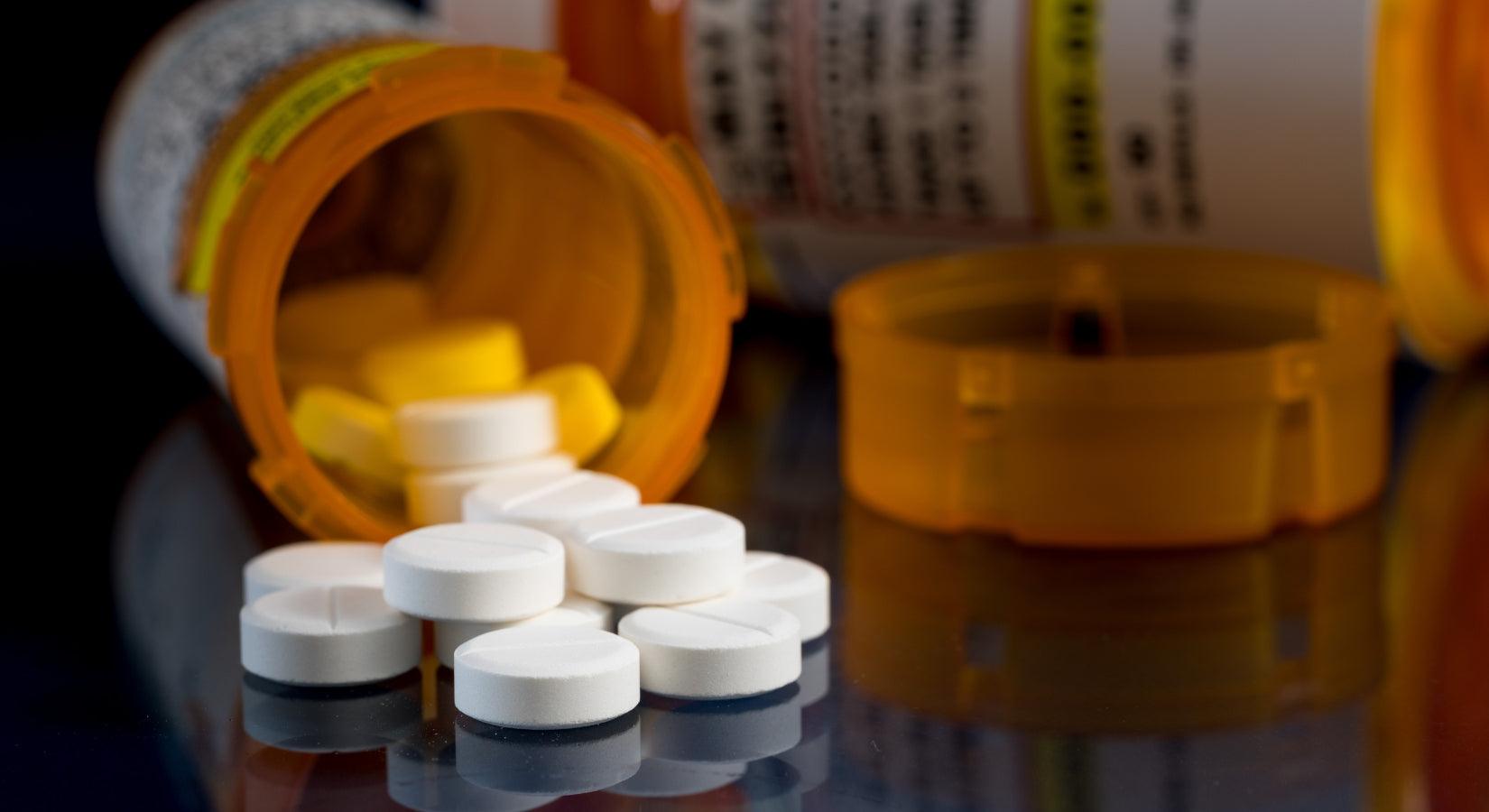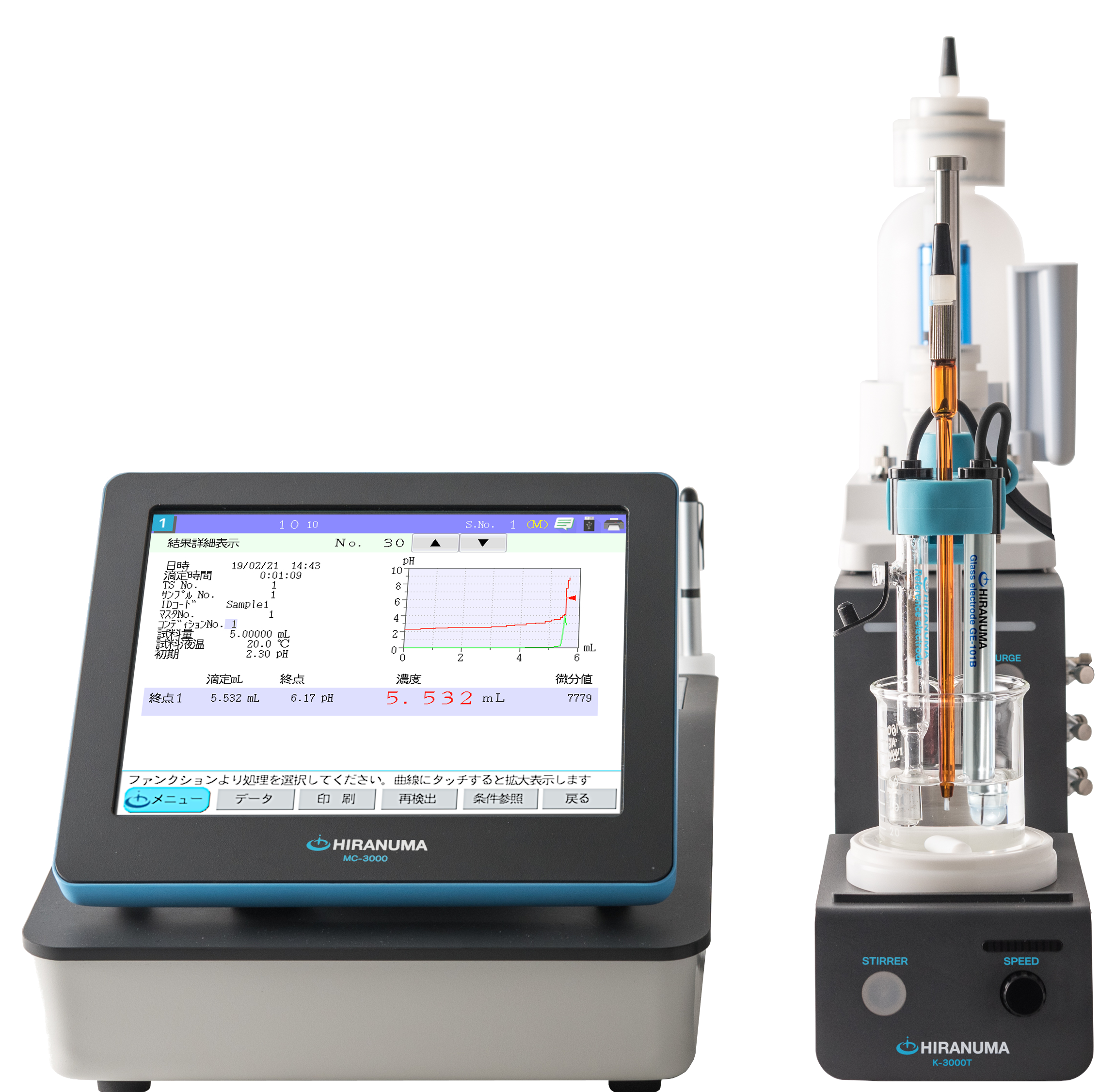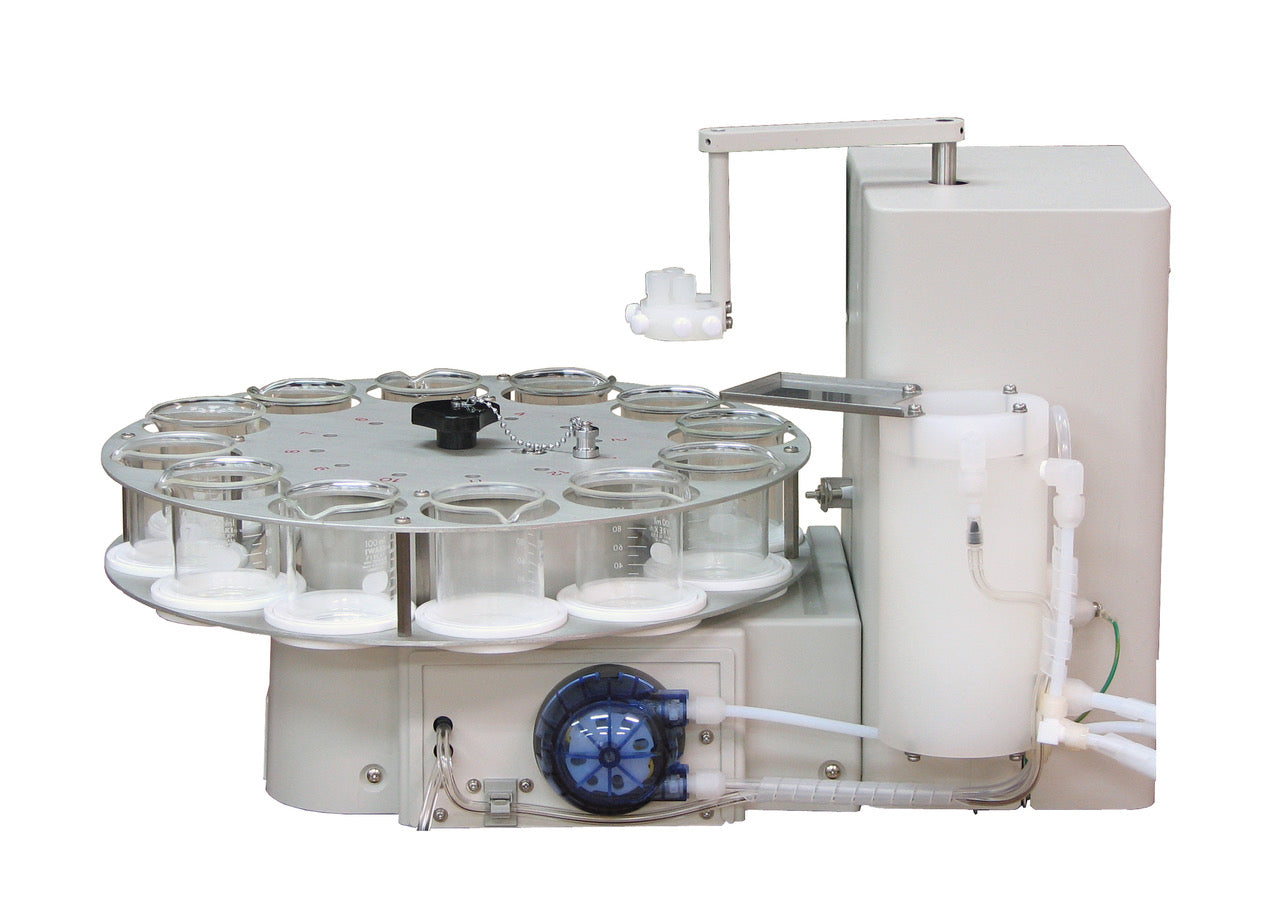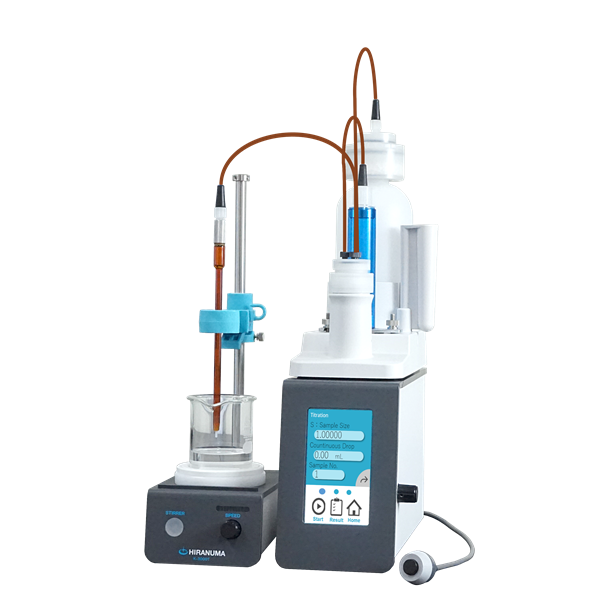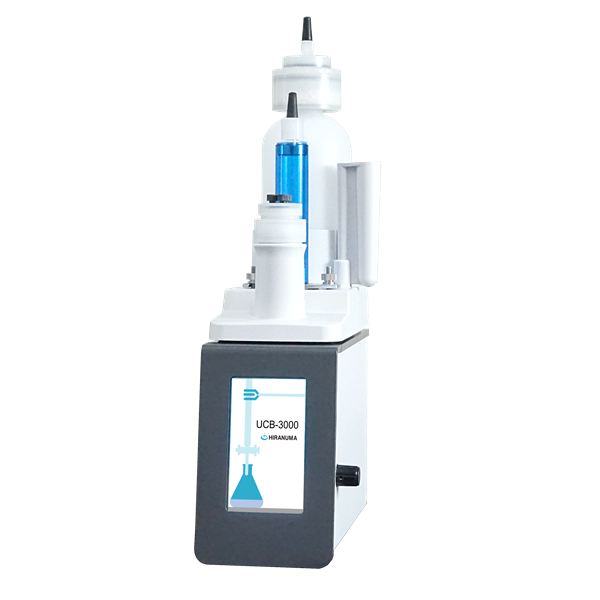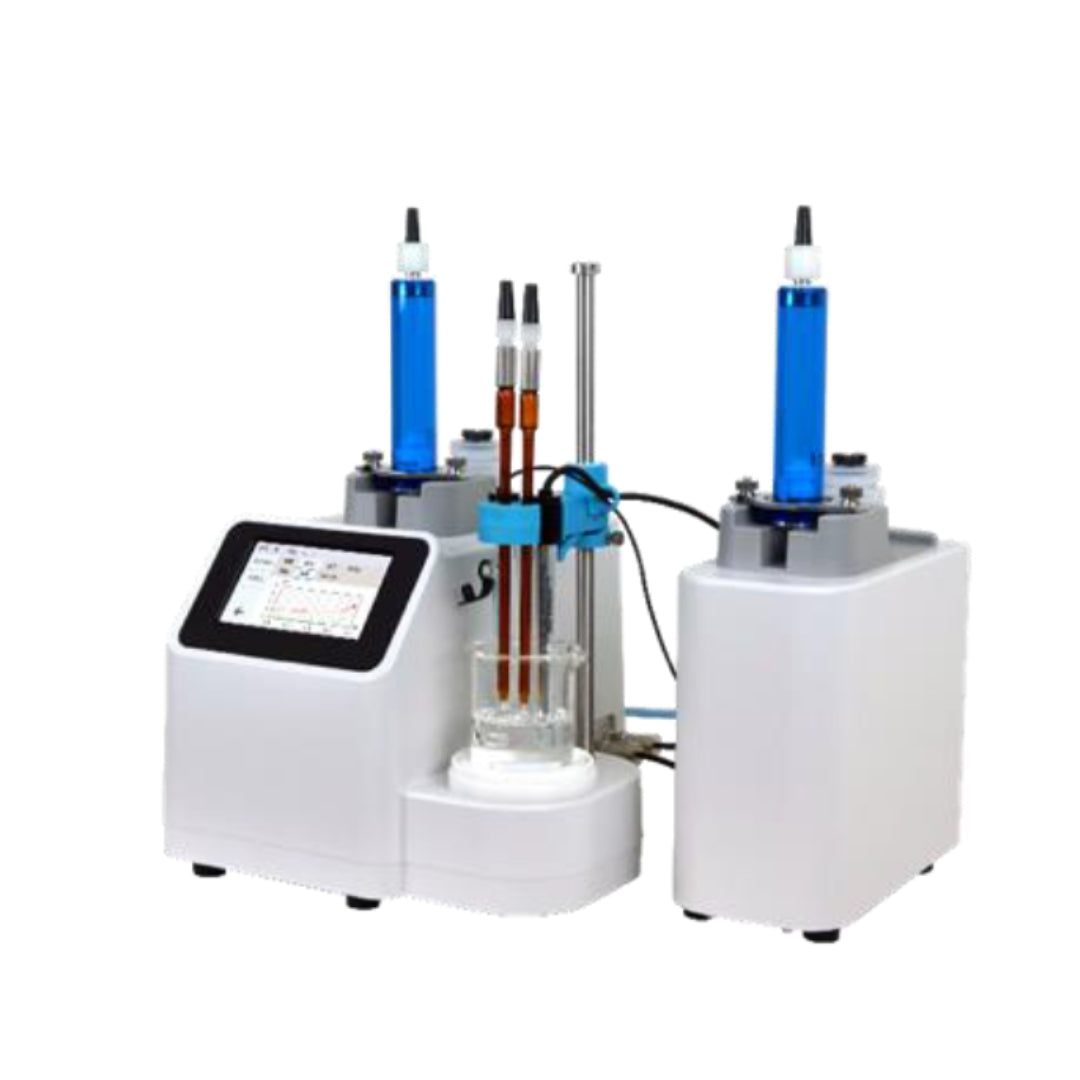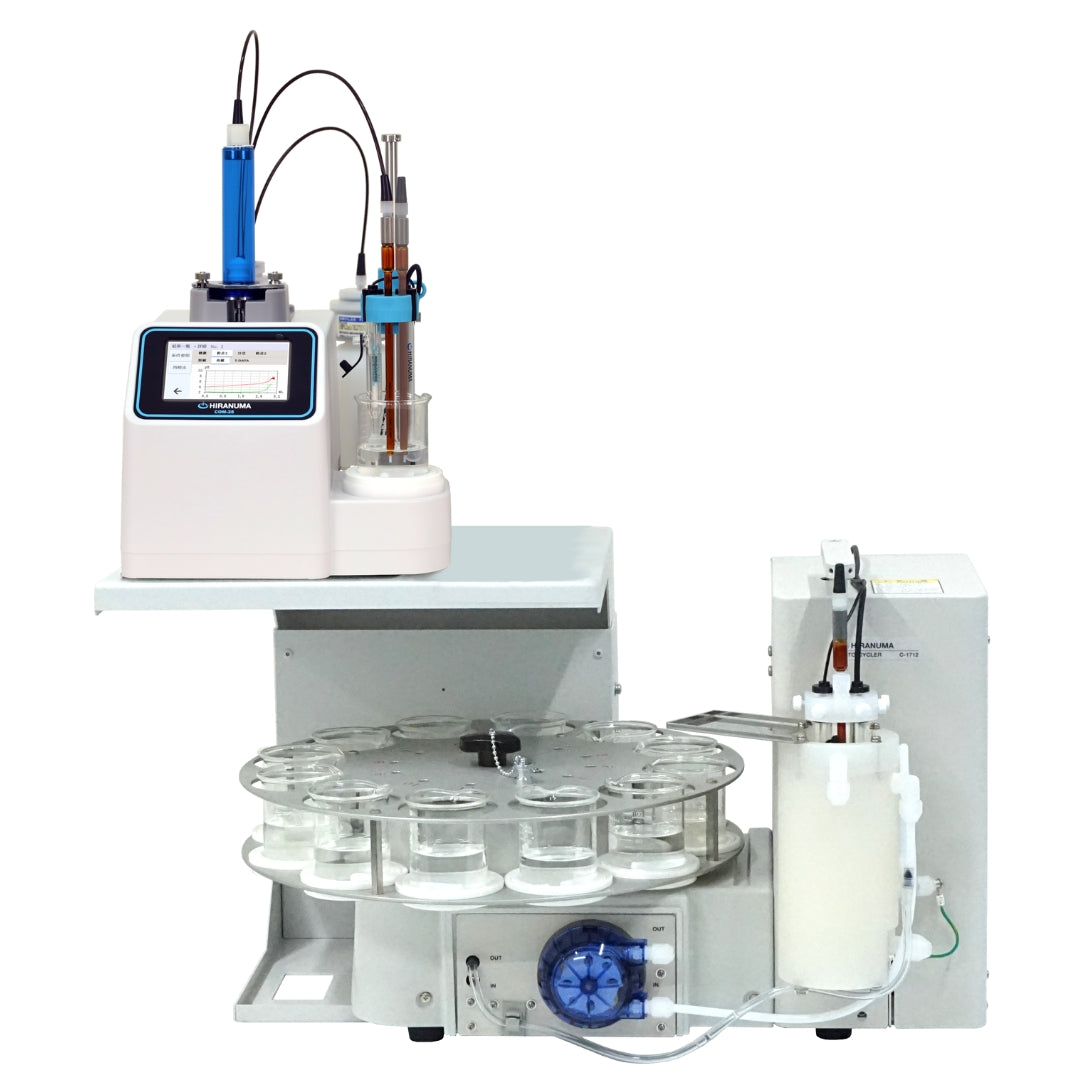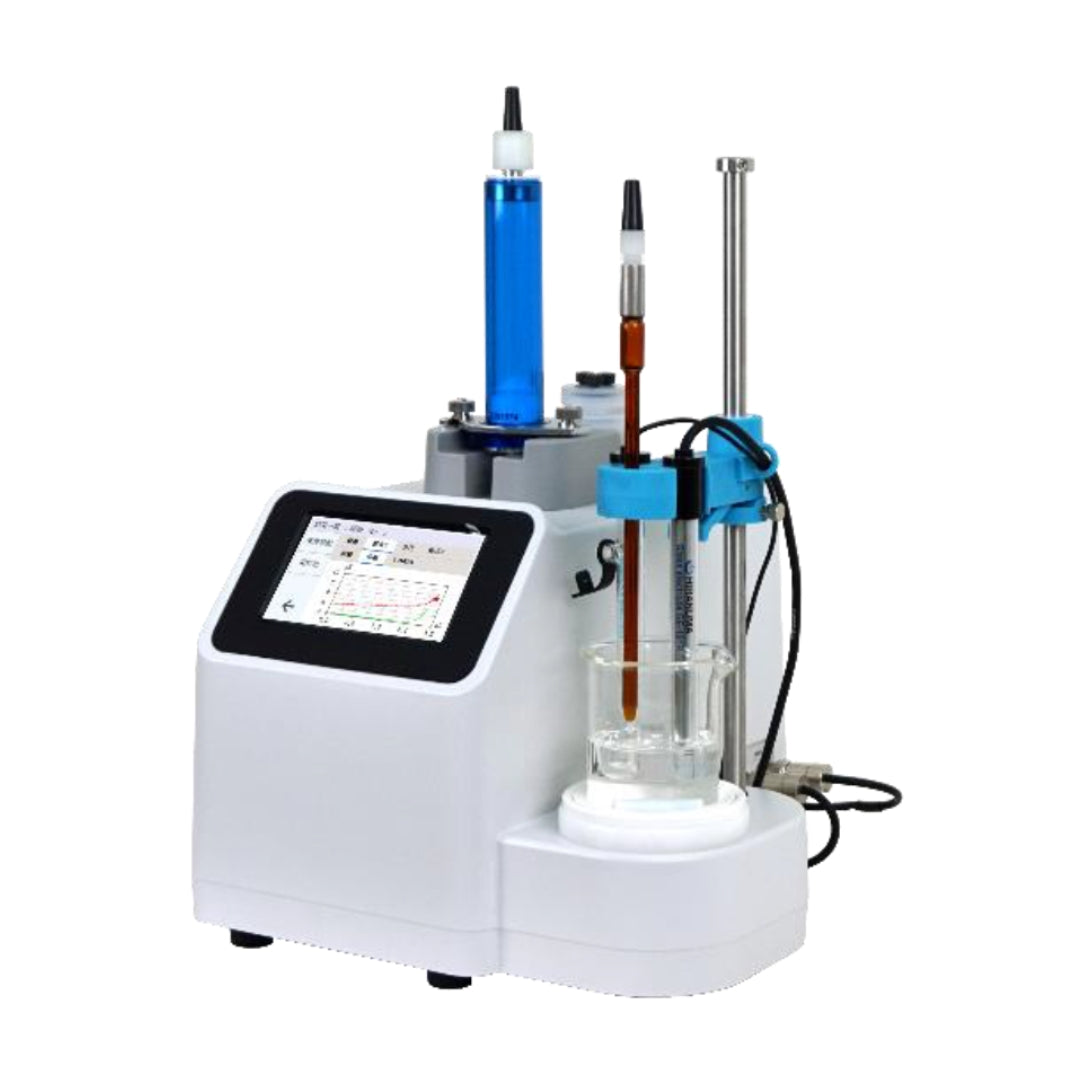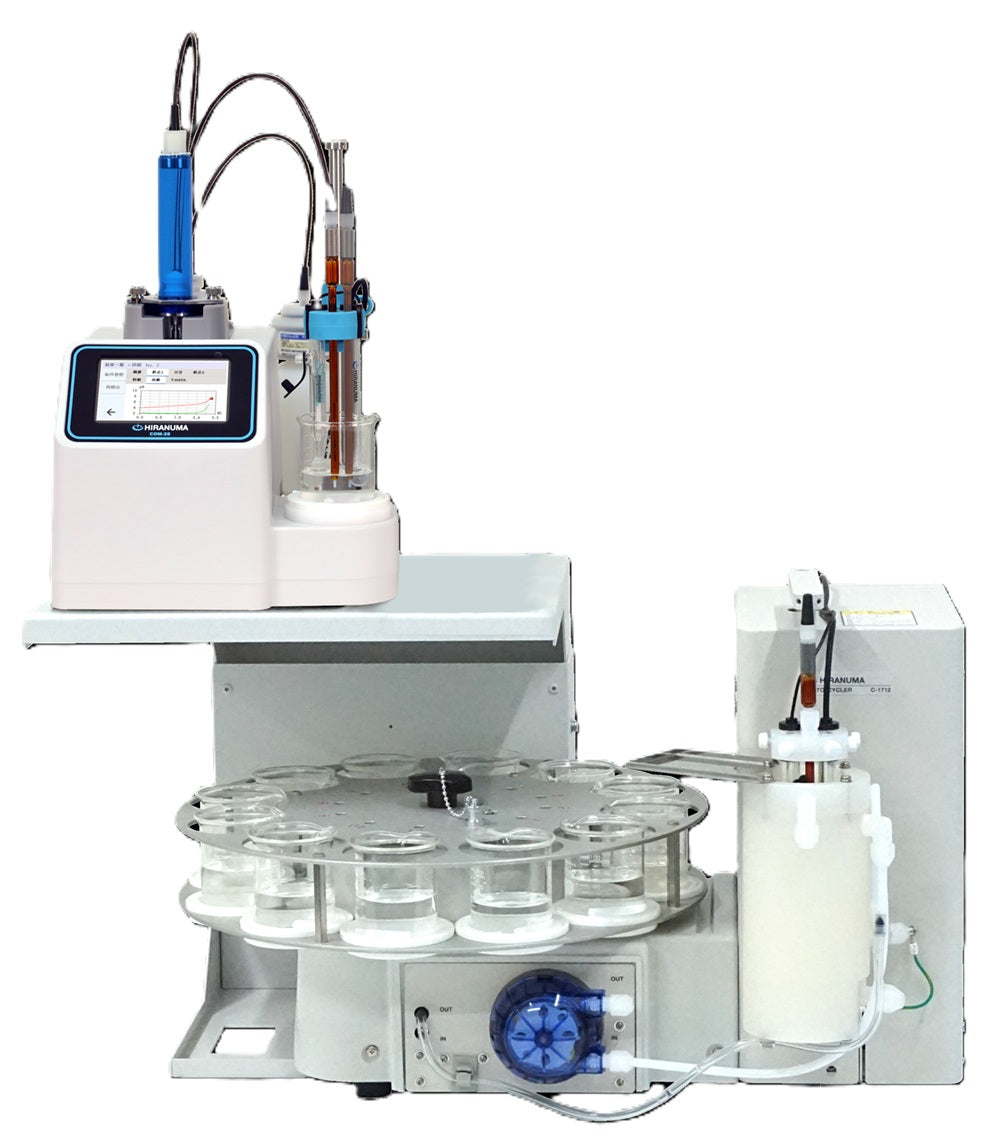| HIRANUMA APPLICATION DATA | Karl Fischer Titrator | Data No. | KF22 | Apr. 13, 2022 |
| Water contents | Drugs and Medicines – KF Volumetry Back-Titration Japanese Pharmacopoeia – Suitability test |
1. Abstract
Water contents of drugs and medicines could be determined by Karl Fischer volumetric titrator. In volumetric titration, the titrant have a factor which means the ability to react with how many milligrams of water per 1 mL of titrant. Factor is pre-determined before sample measurement and water content of sample is calculated from consumed titrant volume within sample measurement.
There are two methods in KF volumetric titration, forward-titration and back-titration. Forward-titration is used in general. However, some of the sample should be measured by back-titration method according to Pharmacopeias.
In this report, the suitability test of Japanese Pharmacopoeia Eighteenth Edition was performed for dextromethorphan hydrobromide monohydrate, also introduced in Application Data No. 11, with back-titration method. Please refer to Application Data No. 11 for the factor determination of titrants procedure and the repeatability of measurement results for dextromethorphan hydrobromide monohydrate.
Reference
1) Japanese Pharmacopoeia Eighteenth Edition
2. Apparatus and Reagents
| (1) | Apparatus | ||
| Titrator | : | HIRANUMA Karl Fischer Volumetric titrator AQV-series or MOIVO-A19 | |
| Additional Buret | : | 1 unit | |
| Titration cell | : | Standard cell without drain valve | |
| Sampler | : | Syringe Powder funnel (Outer diameter of leg less than 12 mm) |
|
| (2) | Reagents | ||
| KF Titrant | : | AQUALYTE KF3 (HIRANUMA) An alternative if it is difficult to prepare, HYDRANAL Composit 5 (Honeywell) |
|
| Water-in-methanol solution |
: | 2 mg/mL, prepared from reagent grade methanol and DI water | |
| Titration solvent | : | HYDRANAL Methanol Dry (Honeywell) | |
| (3) | Sample | ||
| Measurement sample | : | Dextromethorphan Hydrobromide Monohydrate (Guaranteed reagent) | |
| Standard material | : | AQUALYTE Water Standard 10 (Assay: 10.06 mg/g, HIRANUMA) An alternative if it is difficult to prepare, HYDRANAL Water Standard 10 (Honeywell) |
3. Procedure
3.1. Blank test measurement by forward-titration
| (1) | Fill 40 mL of titration solvent into the titration cell. |
| (2) | Start blanking to attain stable background. |
| (3) | Open the stopper of titration cell lid and introduce the funnel. Without adding the sample, leave to stand for the same amount of time as it takes to add the sample in section 3.2, then attach the stopper. |
| (4) | Start blank test with forward-titration. Measurement parameter is shown in Table 4.1. |
| (5) | Set the result of titrant volume obtained in the blank test as the blank value for the measurement conditions of the sample. |
3.2. Procedure for suitability test
| (1) | Fill 40 mL of titration solvent into the titration cell. |
| (2) | Start blanking to attain stable background. |
| (3) | Put a sample container, powder funnel and spoon on the balance. Record its read (Size 1 [g]). |
| (4) | Open the glass stopper of titration cell lid to introduce the sample with powder funnel as shown in Fig.3.1. The addition amount is adjusted so that the detected water (mg) is within 5 to 30 mgH2O. |
| (5) | Start titration. First, 10 mL of KF titrant is dispensed into the cell and then titrated with water-in-methanol solution. Measurement parameter is shown in Table 4.2. Set the factors determined preliminarily for the KF titrant and the water-in-methanol solution. |
| (6) | Weigh the sample container, powder funnel and spoon again and record its read (Size 2 [g]). The difference of (Size 1-Size 2 [g]) is set as sample size. |
| (7) | After measurement of the sample is finished, the device, setting parameters, and reagents are used without change, and the water standard is measured subsequently. Wash the syringe with the water standard and draw it into syringe. Then, weigh the syringe and record its read (Size 1 [g]). |
| (8) | Open the glass stopper of titration cell lid to introduce the water standard. The injection amount is adjusted so that the detected water (mg) is 50 to 100 % of that of the sample measurement. Weigh the syringe again (Size 2 [g]). The difference of (Size 1-Size 2 [g]) is set as sample size. |
| (9) | Repeat the measurement of the water standard 5 times. |

Fig.3.1 Introduction of sample with powder funnel
3.3 Analysis of suitability test result
| (1) | Prepare the value required for analysis from measurement result. |
| M :Determined water in the sample measurement result (mgH2O) ⇒ Initial water content determined for sample (mgH2O) |
|
| M1-x :Amount of added water in the water standard measurement (mgH2O), “X” indicates the number of water standard measurement Added amount of water standard (g) × Water assay of water standard (mgH2O/g) ⇒ Amount of water added (mgH2O) |
|
| M2-x :Amount of found water in the water standard measurement result (mgH2O), “X” indicates the number of water standard measurement ⇒ Amount of water found (mgH2O) |
|
| (2) | Plot as follows using spreadsheet software. |
 |
|
| (3) | Create a regression line for the plots and find the following values. |
| b : Slope of regression line | |
| a : y-axis intercept | |
| d : x-axis intercept | |
| (4) | The percentage errors e1 (%) and e2 (%) are calculated from the following formulae. |
| e1 = {(a-M)/M} × 100 | |
| e2 = {(|d|-M)/M} × 100 | |
| (5) | From the following formula, calculate the water recovery rate r (%) for each of the 5 measurements of the water standard, and calculate the average water recovery rate R (%). |
| r (%) = (M2-X/M1-X) × 100 |
4. Parameters and results
Table 4.1 Parameters for blank test by forward-titration method
| Item | ||
| Cal Mode | 13:Auto input blank value mode | |
| Interval Time | 30 | sec |
| Max Volume | 20 | mL |
| Min Feed Vol. | 0.01 | mL |
| S.Timer | 0 | min |
| Item | ||
| KF Buret No. | 1 | |
| KF Speed(OUT) | 24 | mL/min |
| KF Speed(IN) | 24 | mL/min |
| Back Ground | OFF | |
| E.P Detection | uA | |
| C.P Level | 150 | uA |
| E.P Level | 200 | uA |
| Auto Input | OFF |
Table 4.2 Parameters for sample measurement by back-titration method
| Item | ||
| Cal Mode | 11:Back tit1(Fixed KFreagent disp) | |
| Interval Time | 30 | sec |
| Max Volume | 20 | mL |
| Min Feed Vol. | 0.01 | mL |
| S.Timer | 1 | min |
| KF Factor | 2.9263 | mg/mL |
| KF Buret No. | 1 | |
| KF Disp.Vol. | 10 | mL |
| KF Timer | 1 | min |
| MeOH Factor | 2.0279 | mg/mL |
| MeOH Buret No. | 2 | |
| MeOH Disp.Vol. | 0 | mL |
| MeOH Timer | 0 | min |
| Item | ||
| KF Speed(OUT) | 24 | mL/min |
| KF Speed(IN) | 24 | mL/min |
| MeOH Speed(OUT) | 24 | mL/min |
| MeOH Speed(IN) | 24 | mL/min |
| Back Ground | OFF | |
| Sample Size Input | Every Time | |
| Blank Value | 0.01 | mL |
| Unit Mode | AUTO | mL |
| E.P Detection | uA | |
| C.P Level | 150 | uA |
| E.P Level | 200 | uA |
| Auto Interval | 0 | g |

Fig.4.1 Measurement result of the sample

Fig.4.2 Example of measurement results of the water standard
Table 4.3 Results of suitability test procedure
| Sample | Meas. No. |
Meas. Time |
Sample size (g) |
Titrant volume (mL) |
Water (mg) |
Water content (%) |
Statistics result | |
| Blank test | 1 | 0:00:40 | – | 0.01 | – | – | Avg. | 0.01 mL |
| 2 | 0:00:36 | – | 0.01 | – | – | |||
| Sample | 1 | 0:07:33 | 0.2056 | 9.43 | 10.111 | 4.9178 | * M = 10.111 mg | |
| Water standard | 1 | 0:10:54 | 0.7708 | 10.56 | 7.819 | 1.0144 | Avg. | 1.0135 % |
| 2 | 0:14:20 | 0.9248 | 9.82 | 9.320 | 1.0078 | SD | 0.0033 % | |
| 3 | 0:17:54 | 0.8772 | 10.03 | 8.894 | 1.0139 | RSD | 0.32 % | |
| 4 | 0:20:48 | 0.9600 | 9.61 | 9.746 | 1.0152 | |||
| 5 | 0:21:16 | 0.9512 | 9.65 | 9.665 | 1.0161 | |||
Table 4.4 Values used for regression line of suitability test
| Sample | Meas. No. |
Sample size (g) |
Added water M1-x (mgH2O) |
Found water M2-x (mgH2O) |
x-axis Cumulative added water (mgH2O) |
y-axis M + Cumulative found water (mgH2O) |
percentage recovery r(%) |
| Sample | 1 | 0.2056 | – | 10.111 | – | – | – |
| Water | 1 | 0.7708 | 7.754 | 7.819 | 7.754 | 17.930 | 100.8 |
| Standard | 2 | 0.9248 | 9.303 | 9.320 | 17.058 | 27.250 | 100.2 |
| 3 | 0.8772 | 8.825 | 8.894 | 25.882 | 36.144 | 100.8 | |
| 4 | 0.9600 | 9.658 | 9.746 | 35.540 | 45.890 | 100.9 | |
| 5 | 0.9512 | 9.569 | 9.665 | 45.109 | 55.555 | 101.0 |

Fig.4.3 Result of calculated regression line
Table 4.5 Result of suitability test for Japanese Pharmacopoeia
| Item | Result | Standard | Compliant |
| Found water of sample M (mgH2O) | 10.111 | 5~30 mgH2O | OK |
| Average percent recovery R (%) | 100.7 | 97.5~102.5 % | OK |
| y-axis intercept a (mgH2O) | 10.088 | – | – |
| Slope of regression line b | 1.008 | 0.975~1.025 | OK |
| x-axis intercept d (mgH2O) | -10.013 | – | – |
| Percentage error |e1| (%) | 0.2 | 2.5 % or less | OK |
| Percentage error |e2| (%) | 1.0 | 2.5 % or less | OK |
5. Note
A few things note for performing the suitability test
| (1) | In the suitability test, it is necessary to measure the water standard 5 times in succession without changing the titration solvent after measuring the sample. On the other hand, in back-titration, the KF titrant is dispensed and then titrated with water-in-methanol solution, so the increased amount of liquid in the cell per measurement is larger than forward-titration. The upper limit of the liquid volume in the standard cell is 150 mL. In this report, the titration solvent to be added to the cell at first was reduced to 40 mL so that the upper limit of the liquid volume was not exceeded during the suitability test. In the standard cell, the minimum amount of titration solvent to add at first is 30 mL. If the liquid volume exceeds the upper limit of cell during suitability test, use an optional cell with a capacity of 200 mL (P/N: D327512-1 etc.). |
| (2) | Since the water standard is a liquid, it is collected in a syringe and usually injected into the cell through a rubber septum. By injecting through a rubber septum, the liquid sample can be added without the outside air introduced to the cell during the injection. In this report, since the sample of dextromethorphan hydrobromide monohydrate is a solid state, it requires to open the stopper of the cell for adding it. The method of adding the water standard in the suitability test is also performed in same procedure with the sample. |
| Keywords: | Karl Fischer, Volumetric titration, Back titration, Pharmacopeia, Suitability test, Dextromethorphan hydrobromide monohydrate, |

